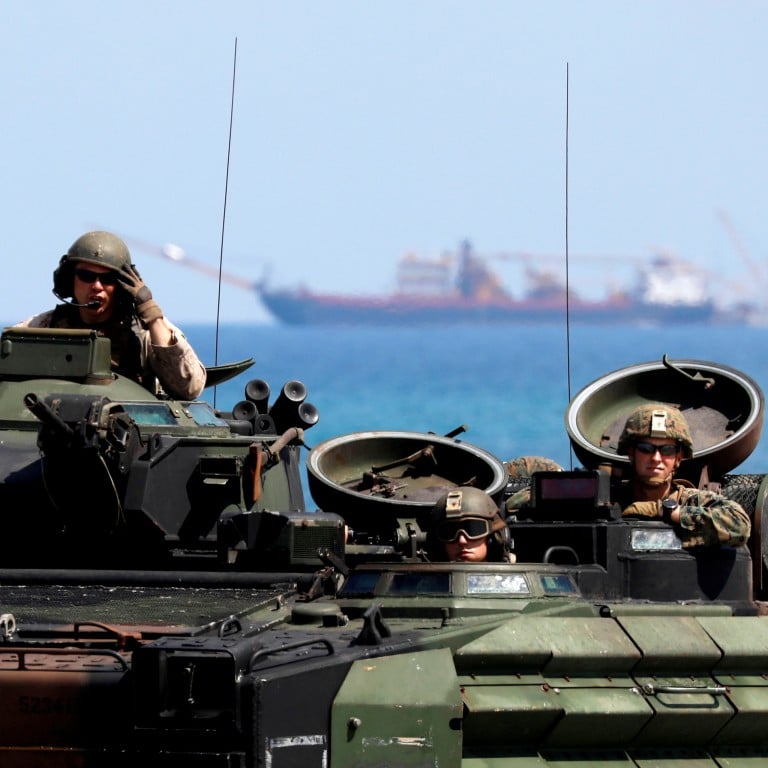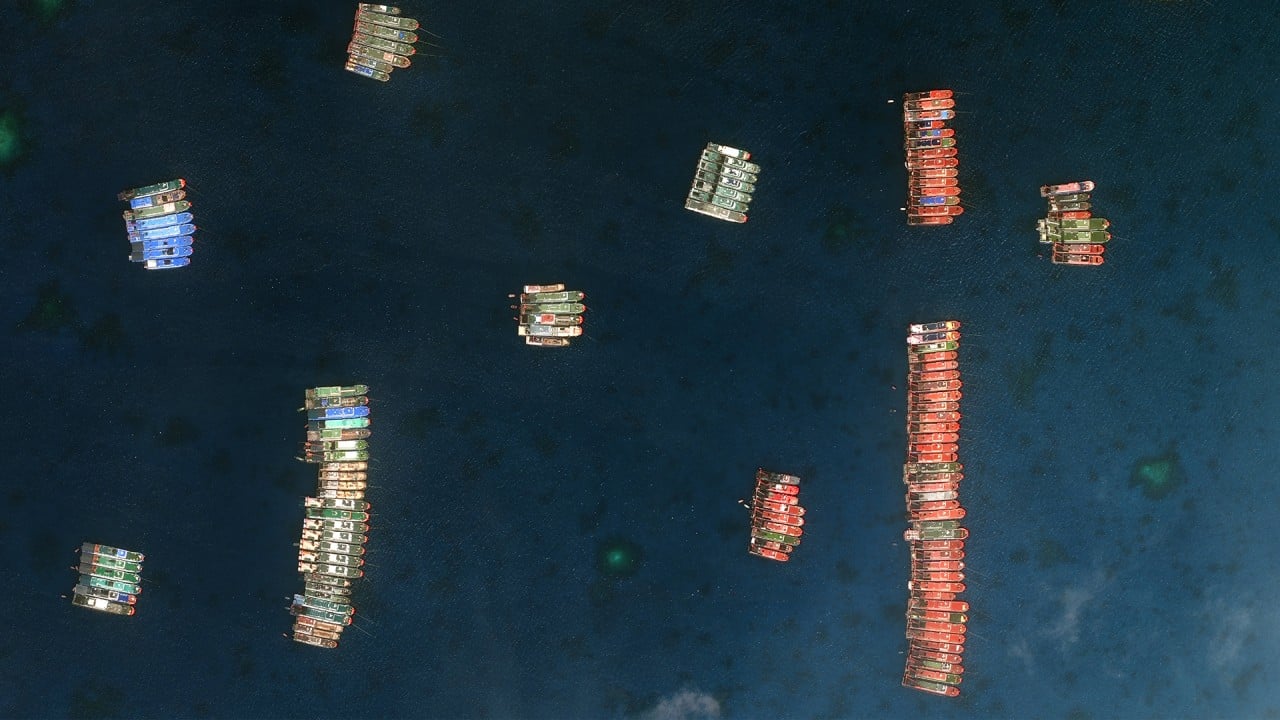
US military, China’s economy: Philippines plays it both ways with Duterte’s VFA U-turn
- After years of anti-American vitriol and repeated threats to scrap a deal that allows US troops to operate in the country, the Philippine leader has seemingly turned on a dime
- Washington may think he’s ‘full of hot air’, but analysts see a deeper game as Manila balances its security needs in the South China Sea with its post-pandemic economic interests
It was a 180-degree turn for Duterte, who in an outburst in February last year vowed to terminate the VFA, a legal framework that makes it possible for US troops to operate and train in the Philippines.
But about nine months before the Philippines elects a new leader – the constitution does not allow Duterte to run again for the top job although he is reportedly considering running as vice-president – questions are brewing about whether Duterte’s China policies have brought the promised benefits. Meanwhile, Chinese encroachment on Philippine maritime territory continues to fuel public anger.
It was this encroachment, according to analysts, along with the Philippines’ close military ties with the US that had made Duterte stick with the VFA after all.
Jose Antonio Custodio, a non-resident fellow of the think tank Stratbase ADR Institute, wasn’t surprised by the turnaround. “From the very beginning there seemed to be hesitation [in scrapping the VFA]”, he said.
Scrapping the treaty required giving six months’ notice, but Duterte “suspended” the termination on three occasions citing various reasons – most recently because he was “studying” the issue.
Experts believe the real reason for the postponements was resistance from the Philippine military, which favours the US. The two countries have a 70-year-old mutual defence treaty that obliges each to come to the other’s assistance if either is attacked.
“The Armed Forces of the Philippines is a pro-American institution: it has relied on American grants, its officers have studied in the US, all this is something that’s difficult to just wish away,” Custodio said.

The generals were not prepared to sunder ties with a traditional ally.
In a commentary in the nationalist Chinese tabloid Global Times, Dai Fan, director of the Centre for Philippine Studies at Jinan University in Guangzhou, said: “The Philippine military … certainly does not want to see the deal abolished. So it must have lobbied the president to keep the deal.”
On July 30, when Lorenzana announced Duterte was no longer going to do away with the VFA, there was no public mention of any payment or revision of the treaty. Austin thanked Duterte and said, “a strong, resilient US-Philippines alliance will remain vital to the security, stability and prosperity of the Indo-Pacific. A fully restored VFA will help us achieve that goal together.”
On August 2, following news that the US had sent the Philippines 6.2 million vaccine doses over three weeks, Duterte said he had renewed the treaty as a “concession” out of “gratitude” for the jabs. With uncharacteristic effusiveness he said, “I would like to thank the president of the United States … the government, and the people of America for not forgetting us.”
He added: “Do not forget us because we share the same outlook on geopolitics here, especially in Southeast Asia.”
Describing the US attitude to Duterte, Custodio said: “The Americans have known ever since that he’s full of hot air.”
In his commentary, Dai surmised that “To maintain its presence, Washington must have coerced Manila to keep the deal.”

Domestic dimension
Collin Koh, research fellow at Singapore’s S. Rajaratnam School of International Studies, suspected “the domestic dimension looms large in the calculation”.
Asked how China was likely to react, Koh said: “I surmise that Beijing doesn’t regard this latest move as necessarily detrimental to the overall scheme of matters.
“I think Beijing might have foreseen this would happen, especially given the repeated suspension of the abrogation of the VFA, which at least demonstrated that Duterte might be toying with the idea of keeping the pact eventually.”
Koh said that “now and in the foreseeable future, the Philippines will continue to place a premium on maintaining healthy diplomatic and economic relations; in other words, Beijing could have come to assess that it enjoys a certain leverage, mainly an economic one, over Manila, and this could well offset the impact of the decision to keep the VFA.”
Custodio said China’s strategy towards the Philippines was “multifaceted”. Maritime issues were the “front door” he said, while its loans to Manila were the “back door”.
“They’re pumping in more loans here, more projects, many of those are provincial. Those can win elections,” he said.

However, a report published by the Australian National University on August 11 on Chinese investment in Southeast Asia between 2005 and 2019 showed that only about 5 per cent of total Chinese foreign direct investment to the region went to the Philippines, though that represented an increase.
The investments were primarily in service provision and the energy sector, the report said.
However, “by a large margin, the Philippines’ top foreign investor is the US (followed by Japan, the EU and South Korea), while Chinese investment is also constrained by corruption scandals and nationalist sentiment due to the South China Sea territorial disputes”, the report authored by Professor Evelyn Goh and research officer Nan Liu at the ANU’s Coral Bell School of Asia-Pacific Affairs said.
US ready to pull troops from Philippines ‘in months’
Balancing US-China
Analysts said that what seemed to be taking shape was a policy that would see the Philippines maintain close military ties with the US while making China its major economic partner.
Dai said that just because the VFA was renewed that “doesn’t mean Manila will align itself closely with Washington to confront Beijing”.
“Even if a president adopts pro-US policies, he is not necessarily anti-China,” he added.
Koh saw the “current situation as straddling between the two powers. While it may be popular to say that Duterte’s keeping of the VFA means Manila is now firmly in the US camp from now on, the situation is more nuanced than this.”
In an article for the South China Sea Strategic Situation Probing Intitiative (SCSPI) Rommel Banlaoi, president of the Philippine Association for Chinese Studies, said China was “a big neighbour next door that can offer huge economic opportunities to the Philippines that the US can no longer provide. Though the US can still provide the security needs of the Philippines. Manila is compelled by the current situation not to choose between China as close neighbour and the US as a distant relative.”

“Rather, the Philippine government wants to get the best of both worlds to advance the Philippines’ national interests,” Banlaoi wrote. The SCSPI operates out of Peking University’s Institute of Ocean Research.
Koh said he was “intrigued” by the thought that Duterte might be playing a deep game.
“The popular mainstream perception cultivated by media reports is that Duterte has since 2016 slanted towards Beijing. While that may appear to be true, it’s apparent over these years that he remains keen to keep the American card in his pocket.”
“Keeping the VFA offers a layer of insurance for Manila in the South China Sea, and this signals to Beijing that the American card would still be utilised if push comes to shove. However, at the same time, the Philippines definitely still needs China for its post-pandemic economic recovery and growth – export market access, infrastructure investment, vaccine cooperation, for example.”
Manila’s balancing act, however, faces a political imponderable: Will whoever succeeds Duterte be as successful in showing warmth and closeness to China?
Filipinos and the Philippines have historically been close to the US, where more than four million Filipino-Americans live. There is no comparable population in China.
Dai warned that “Filipino politicians should be wise enough to realise that their country should not sacrifice its own interest by serving the demands of Washington.”
Meanwhile, Dai said, making an enemy of China was for smaller countries like the Philippines “equal to strategic suicide”.


